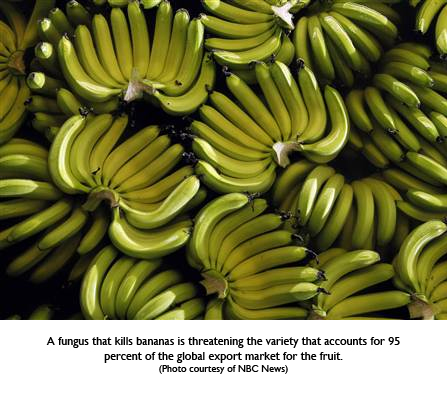Bananas can’t seem to catch a break.
The fruit is under assault again from a disease that threatens the popular variety that Americans slice into their cereal or slather with chocolate and whipped cream in their banana splits. But aside from its culinary delight, the banana is the eighth most important food crop in the world, and the fourth most important one for developing nations, where millions of people rely on the $8.9 billion industry for their livelihood.
“It’s a very serious situation,” said Randy Ploetz, a professor of plant pathology at the University of Florida. In 1989 Ploetz discovered a strain of Panama disease, called TR4, that may be growing into a serious threat to U.S. supplies of the fruit and Latin American producers.
“There’s nothing at this point that really keeps the fungus from spreading,” he said in an interview with CNBC.
 While there are nearly 1,000 varieties of bananas, the most popular is the Cavendish, which accounts for 45 percent of the fruit’s global crop — and the one Americans mostly find in their supermarkets.
While there are nearly 1,000 varieties of bananas, the most popular is the Cavendish, which accounts for 45 percent of the fruit’s global crop — and the one Americans mostly find in their supermarkets.
The Cavendish became a favorite in the 1950s because it was found to be resistant to strains of Panama disease that hit the then-preferred Gros Michel variety of banana.
But now the Cavendish, which makes up about 95 percent of global banana exports, is dying from the fungus strain Ploetz found. The strain has hit the banana crop in Asia, the Middle East and Africa. The worry is that it will spread to Central and South America — where the U.S. gets the vast majority of its bananas.
The problem has gotten so bad, according to the United Nations Food and Agriculture Organization, that countries that grow bananas have been warned to step up monitoring, reporting and prevention in order to tackle what it calls “one of the world’s most destructive banana diseases, and threatens the income of millions of people.”
Bananas are grown in more than 150 countries, which produce 105 million tons of fruit per year, while employing hundreds of thousands of people. The U.S. is the top importer of bananas in the world at nearly 4 million tons a year. The European Union is a close second. The largest exporters of the fruit are Ecuador, the Philippines, Costa Rica, Guatemala and Colombia.
Panama disease, or Fusarium wilt as it’s also called, has been around for decades and can strike crops such as tobacco and tomatoes as well as bananas.
The TR4 strain, while not a danger to humans, is found in the soil and can remain active for decades, but it cannot be fully controlled by fungicides. The best way to fight the disease, according Ploetz, is to prevent its spread, which includes avoiding movement of diseased plant materials and infected soil.
As for it coming to Central and South America, at least one analyst on the scene is not too worried at this point.
“I see a lot of people stressed … and we’re monitoring the situation, but I think it may be a bit overblown,” said Lianne Zoeteweij, general manager of AsoGuabo, a banana farm cooperative in Ecuador.
“We have concern, yes, but I think the warnings of bananas disappearing is too much,” she told CNBC.
The world banana crop also has been under attack for years from Black Sigatoka disease, a fungal leaf spot disease. Coupled with TR4, the diseases slowed world banana production by as much as 3.8 percent in 2012, from 2011, according to the FAO.
TR4 may not be in the Americas yet, but Costa Rica declared a “banana emergency” in December 2013 because of an outbreak of insects that feed on the fruit that leave bananas edible but not suitable for exporting.
Ploetz said it may come down to developing a new variety of the fruit that’s resistant to the TR4 strain, which could take years.
“Bananas won’t go away and there are better tasting ones out there. But the Cavendish is under attack right now, and there’s nothing to replace it,” he said.
Source: NBC News
